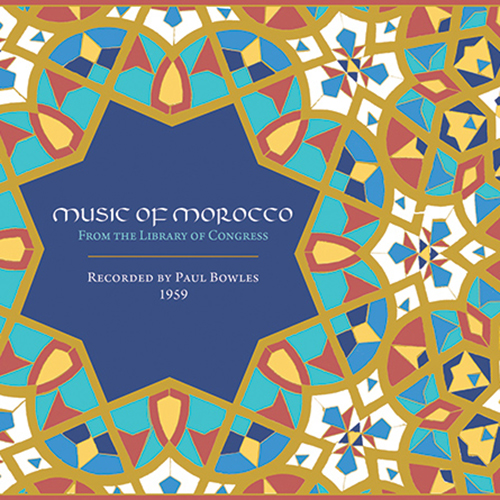Paul Bowles is a singular, maverick figure whose life and work intertwine music, literature and pop culture in the 20th century. As a young American writer and composer, he first traveled to Morocco with Aaron Copland in 1931. He fell in love. (Copland did not.) Bowles returned a number of times, and in 1947 moved there permanently, living in Tangier until his death in 1999. In his house, now a Tangier landmark, Bowles famously hosted Beat poets—Ginsberg, Corso, Burroughs et al—composed Western music, and wrote such memorable novels as The Sheltering Sky and The Spider’s House. Although his writings were mostly set in Morocco, the music he composed resisted any influence from his adopted home. The local music “was there simply for living, not as material for anything else.” That’s not to say Bowles didn’t love Moroccan music. In fact, it was a kind of obsession for him, one that reached full flower in 1959, the year that all the recordings on this marvelous four-CD package were made.
Bowles made four six-week excursions through the northern half of the country that year, “capturing” all he could. He was hampered by bureaucracy, ever more intransigent and mistrustful government officials, “blistering heat,” and the fact that his Ampex 601 reel-to-reel tape recorder required electricity, not always available, which meant that musicians often had to be transported to recording sessions in towns with appropriate power infrastructure. Despite all this, Bowles traveled the Moroccan roadways diligently in a Volkswagen Beetle, recording what he believed to be disappearing music.
This release is an expanded version of the original 1972 Library of Congress recording. It comes in a handsome box with a leather-bound, 120-page booklet including photographs, a map of the four field trips, Bowles' 1972 sleeve notes, an essay by Lee Ranaldo, plus further entries from his field notes and excellent commentary from ethnomusicologist Philip Schuyler, who produced and re-edited the collection. Schuyler knew Bowles and began planning this enhanced release with him many years ago.
On one level, this presentation is a fascinating interaction between an enthusiast and a scholar—something Bowles proudly professed not to be. Referring to a particular track, Schuyler notes that, “Bowles had recorded the music the way he wanted it to sound, conjuring up an image of a place that didn’t quite exist.” In a sense, that applies to the entire project. Bowles asks a Gnawa musician to remove the buzzing, metal sersal from his gimbri lute because he finds that its distinctive rattle distorts the music. He persuades a flute player to perform solo, although his instrument is traditionally played with an accompanying drum, by telling the player that the American government wishes it that way. In fact, Bowles wished it that way, and it’s easy to sympathize, as the solo track is sublime. A little paradoxically, Bowles also strenuously objects to anything that seems to “modernize” the music. He always wants to hear the older, traditional version of everything—so long as nothing about it offends his rather particular sensibilities.
Paradoxes aside, Bowles had high standards and ultimately, he was looking for an emotional experience, not scholarly insight. He excluded a number of recordings he felt were sub-par, and while Schuyler has occasionally made substitutions and additions (always duly noted), what we get here is really Bowles’ vision of Moroccan music. This is one reason why this collection is such a delight to hear. Most tracks are presented at full length, whereas they were often truncated in the 1972 release. This allows a Berber wedding dance or Andalusian nuba to extend over 10, 20 minutes or more, often producing an experience of “hypnosis”—Bowles rejected the now-ubiquitous term “trance”—for the listener.
The first two CDs present music of the highland Berbers with their frame drums, horsehair fiddles, double-reed wind instruments, flutes, hand-clapping, male and female choruses, and plenty of ululation punctuating these often joyful sessions. The second two CDs present lowland music, what Bowles terms “Influent Strains,” by which he means music that includes Arabic, Jewish or Andalusian elements. Two tracks of Sephardic Jewish vocal pieces on disc four are especially beautiful, as are two lengthy, orchestral Andalusian pieces near the end of the collection. One can find higher-fidelity recordings of Gnawa music than Bowles made, and as Schuyler notes, this is certainly not a complete picture of Moroccan music, even in 1959. But it is a rich and rewarding audio tableau, one that Bowles himself treasured for the rest of his life. He did very little recording of Moroccan music after this. Documentation was not a calling for him, just a project, undertaken with relentless energy, focus and zeal.
To listen through these recordings, and to read the annotations—Bowles observing as a writer and fan, and Schuyler gently correcting and adding just enough, but not too much, ethnographic context—is to share in a conversation across time, space and professional perspective. For any lover of North African music, this collection is a feast, a delight, a must.








